Flag of Algeria
The national flag of Algeria (Arabic: علم الجزائر, Berber languages: ⴰⵏⴰⵢ ⴰⴷⵣⴰⵢⵔⵉ, Anay azzayri, French: Drapeau de l'Algérie) consists of two equal vertical bars, green and white, charged in the center with a red star and crescent, a symbol of Islam as the nation's prominent faith. The flag was adopted on 3 July 1962. A similar version was used by the Algerian government in exile from 1958 to 1962. The Western blazon is per pale vert and argent; a crescent and star gules.
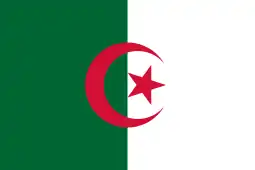 | |
| Use | National flag, civil and state ensign |
|---|---|
| Proportion | 2:3 |
| Adopted | 3 July 1962 |
| Design | A vertical bicolor of green and white, with the red crescent encircling the red five-pointed star centered along the dividing line. |
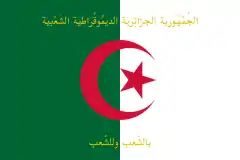 | |
| Use | Presidential standard |
| Proportion | 2:3 |
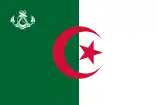 | |
| Use | Naval ensign |
| Proportion | 2:3 |
| Adopted | 27 June 1963 (amended in 1995) |
| Design | As above, with white crossed fouled anchors in the canton. |
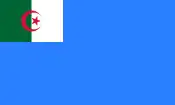 | |
| Use | Naval jack |
| Design | The national flag in the canton on a light blue field. |
History
Numerous Arab and French sources unanimously agree on the tricolor Algerian flag of red, green and yellow horizontal bands, raised first by the Corsair then Sultan Oruç Barbarossa,[1][2][3] the founder of the Regency of Algiers, which was a tributary state of the Ottoman Empire in North Africa from 1516 to 1830,[4] the tricolor flag seemed to be raised on the main gate of Bab Azzoun in Algiers, as well as the Djenina palace, forts and other governmental buildings in Algiers, the flag also accompanied the forces of the regency in notable battles like the Algiers expedition of 1541 and the siege of Malta,[5] it was branded as "insolent"[6] and "terrible".[7] It was even described as the "national flag of Algiers".[8][9]

The Barbary pirates of Ottoman Algeria between the 15th and 17th century widely used flags that were emblazoned with one or more crescents. These could however vary greatly in color, with dark red, black, green and white being in use. Besides these, Algerian pirates also used various flags in plain color, such as plain black ones signalling death. Less often, Algerian flags of this time also carried other motifs, such as suns, stars and crossed swords.[10] It is also known that city of Algiers used an orange flag with a white horizontal sword on it by the early 19th century.[11]
While there is some dispute over who exactly designed the green and white with red star and crescent symbol,[12] Émilie Busquant, wife of the Algerian nationalist leader Messali Hadj, is generally credited as having sewed the first version of the flag in 1934.[13]
Historian Benjamin Stora explains that it was during a meeting of the Étoile Nord-Africaine, in 1934, that the colors of the flag were chosen, after which Émilie Busquant was tasked with sewing it.[14] However, René Gallissot and Anissa Bouayed affirm that this is not the first appearance of the Algerian flag, as Algerian trade union demonstrators displayed this same flag (green and white with a red star and crescent) during the May Day parades in 1919 and 1920, in France and Algeria.[15][16]
Description
Algerian ships fly it as their ensign, except for ships of the Algerian National Navy, which use one charged with two white crossed anchors in the canton as the naval ensign. Formerly, the two crossed anchors in the canton were red.
According to algeria-un.org, cited in 1999, the features of the flag are set down precisely, being described as:
The green must be a composition of equal yellow and blue having, according to the diagram of contrasts of Rood, a wavelength of 5,411 [ångströms] and the position 600 on the normal spectrum. The red must be pure, of primary non-decomposable colour, and exempt of blue and yellow having, according to the above-indicated diagram, a wavelength of 6,562 [ångströms] and the position 285 on the normal spectrum.[17]
Colours scheme | Red | Green | White |
|---|---|---|---|
| RGB | 210-16-52 | 0-102-51 | 255-255-255 |
| Hexadecimal | #D21034 | #006633 | #FFFFFF |
| CMYK | 0, 92, 75, 18 | 100, 0, 50, 60 | 0, 0, 0, 0 |
| Pantone | 186 C | 356 C | White |
Construction Sheet
.svg.png.webp) flag construction sheet
flag construction sheet
Historical flags
.svg.png.webp) Flag of the Kingdom of Tlemcen (1235–1556)
Flag of the Kingdom of Tlemcen (1235–1556).svg.png.webp) Flag of Hafsid Emirate of Béjaïa (1285–1510)
Flag of Hafsid Emirate of Béjaïa (1285–1510).jpg.webp) Flag of the Kingdom of Beni Abbas (1510–1872)
Flag of the Kingdom of Beni Abbas (1510–1872)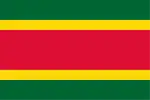 Flag of the Regency of Algiers (1516-1830)
Flag of the Regency of Algiers (1516-1830) Flag of the Emirate of Abdelkader (1832–1847)
Flag of the Emirate of Abdelkader (1832–1847).svg.png.webp) Flag of French Algeria (1830-1962)
Flag of French Algeria (1830-1962).svg.png.webp) Naval ensign of French Algeria (1848–1910)
Naval ensign of French Algeria (1848–1910).svg.png.webp) Flag of Algerian nationalists in 1940
Flag of Algerian nationalists in 1940.svg.png.webp) Flag of the Sétif revolt (1945)
Flag of the Sétif revolt (1945).svg.png.webp) Variant of the flag of the Provisional Government of the Algerian Republic (1958–1962)
Variant of the flag of the Provisional Government of the Algerian Republic (1958–1962).svg.png.webp) Variant of the flag of the Provisional Government of the Algerian Republic (1958–1962)
Variant of the flag of the Provisional Government of the Algerian Republic (1958–1962)
See also
References
- توفيق, مدني، أحمد (1984). حرب الثلاثمائة سنة بين الجزائر واسبانيا، 1492-1792 (in Arabic). المؤسسة الوطنية للكتاب،. p. 175.
- Garrot, Henri (1910). Histoire générale de l'Algérie (in French). Impr. P. Crescenzo. p. 360.
- Tarek Kahlaoui (2018). Creating the Mediterranean Maps and the Islamic Imagination. Brill. p. 216. ISBN 9789004347380.
- McDougall, James, ed. (2017), "Ecologies, Societies, Cultures and the State, 1516–1830", A History of Algeria, Cambridge: Cambridge University Press, pp. 9–48, ISBN 978-0-521-85164-0, retrieved 2023-09-14
- Drohojowska.]), A. S. de DONCOURT (Chevalier, pseud [i e the Countess Antoinette Joséphine Fránçoise Anne (1875). Les Fastes de la Marine Française. Marine militaire (in French).
{{cite book}}: CS1 maint: multiple names: authors list (link) - Marius Bernard (1887). L'Algérie qui s'en va (in French). Plon, Nourrit. p. 39.
- DROHOJOWSKA, Countess Antoinette Joséphine Françoise Anne (1848). L'historie d'Algérie, racontée à la jeunesse ... ouvrage ... précédé d'une préface de D. Lévi Alvarès ... et faisant suite au cours d'histoires racontées á la jeunesse ... par M. Lamé Fleury (in French).
- Léon Galibert (1844). ancienne et moderne depuis les premiers éstablissements des Carthaginois jusqu'à la prise de la Smalah d'Abd-el-Kader (in French). Furne. p. 181.
- مولود قاسم نايت بلقاسم (1985). شخصية الجزائر الدولية وهيبتها العالم العالمية قبل سنة ١٨٣٠, Volume 1 (in Arabic). دار البعث. p. 142.
- Konstam (2016), pp. 34–37, 40, 43, 52, 56, 57 61.
- Konstam (2016), p. 61.
- Houda, B. (20 August 1997). "Le vert, le blanc, l'étoile et le croissant Qui a conçu le drapeau algérien ?". El Watan. Archived from the original on 13 March 2012. Retrieved 28 February 2017.
- Kessous, Mustapha. "Emilie Busquant la plus algerienne des francaises".
- Benjamin Stora, Nationalistes algériens et révolutionnaires français au temps du Front populaire, L'Harmattan, 1987, p. 94, extrait en ligne.
- René Gallissot; Anissa Bouayed (2006). Algérie. Engagements sociaux et question nationale : de la colonisation à l'indépendance de 1830 à 1962. Éditions de l'Atelier. p. 176.
- Gallissot, René (December 30, 2004). "Deux notices du Dictionnaire biographique du mouvement ouvrier-Algérie". Insaniyat / إنسانيات. Revue algérienne d'anthropologie et de sciences sociales (25–26): 143–158. doi:10.4000/insaniyat.6325. ISSN 1111-2050. Retrieved December 17, 2022.
- "Thanh-Tâm Lê, 2 January 1999 (crwflags.com)". 1999. Retrieved 2016-06-15.
Bibliography
- Konstam, Angus (2016). The Barbary Pirates. 15th–17th Centuries. Oxford: Osprey Publishing. ISBN 978-1-4728-1543-9.
External links
![]() Media related to Flags of Algeria at Wikimedia Commons
Media related to Flags of Algeria at Wikimedia Commons
- Algeria at Flags of the World
- Flag of Algeria at flagscorner.com Archived 2019-12-12 at the Wayback Machine
